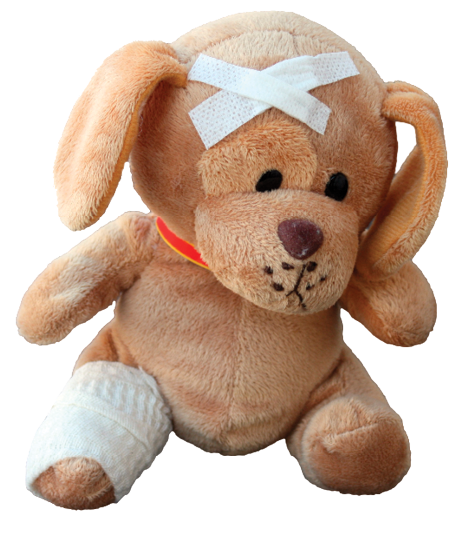
5 Ways to Help Keep Your Toddler Out of the ER
By Christa Melnyk Hines
Toddlers are wonderfully curious and active little people. But that means they're also prone to injury and illness. Here are five ways to help keep your youngster safe and out of the emergency department – and a few tips if you find yourself there anyway.
Prevent serious illness. Scary high fevers, vicious gastrointestinal bugs and unrelenting colds and coughs are among the many reasons parents decide to haul their kids into the emergency department.
To the extent that you can, ensure your child is well-hydrated and fortified with a variety of nutritious, wholesome foods and avoid exposing them to sick kids. Also, teach them to use their upper arm or a tissue to catch their cough and cover their nose and mouth when they sneeze. Encourage proper hand-washing by sudsing up and rinsing while singing the ABCs together (or another song of your choice) to make it fun.
The flu vaccine is one of the best preventatives during cold and flu season. Get the flu vaccine in October just before flu season begins, says Dr. Gabe Schifman, a pediatric emergency physician. The Centers for Disease Control recommends that everyone over the age of 6 months receives the vaccine. During the 2017 to 2018 flu season, approximately 80 percent of the children who died from the flu did not receive a flu vaccine.
"The flu shot is safe and does not cause the virus," Schifman says. "You can have a low grade fever after a vaccination, but that is just because your body is eliciting a response to the virus, which is what you want. It's starting to begin the fight to develop antibodies to prevent you from getting the infection down the road."
Should you head to the ER if your child has a high fever? It depends. If your child is otherwise drinking fine and the fever comes down with Motrin or Tylenol, it may not warrant a midnight trip to the ER. "But, if it's a 104 fever, they're listless, difficult to wake up and they're not drinking or eating, that is more concerning, and they should be seen," Schifman says.
Jump, jump around? Nope, probably better get down. According to the American Academy of Pediatrics (AAP), with the surging popularity of trampoline parks, pediatric injuries related to all of that bouncing around have soared in recent years. "Trampolines are my least favorite fun event," Schifman says. "All trampolines are hazardous." Injuries related to trampolines include sprains, broken bones and spinal cord injuries. The AAP discourages any child under the age of 6 from jumping on trampolines, even in supervised training programs.
Play it safe. Toddlers most often get hurt by running and falling at the playground. Opt for playgrounds with age-appropriate equipment featuring impact absorbent surfaces like sand, pea gravel, wood chips, mulch and shredded rubber or those with synthetic turf. Avoid those with grass, asphalt, cement, dirt or gravel surfaces. Toddlerhood is an excellent time to teach kids to use safety gear like bicycle helmets and knee pads before they race around on their scooters and trikes. Most major retailers carry toddler-sized helmets and pads in a variety of fun colors for kids to choose from.
Keep out of reach. According to Safe Kids Worldwide, children between the ages of 1 and 2 account for more than half of the medicine-related calls made to poison centers. The most common types of medicines and products that children under the age of 4 get into include ibuprofen, multivitamins and diaper care and rash products. Keep medications and household poisons out of sight and out of reach. If your child does ingest a poisonous substance, before heading to the emergency department, call Poison Control, a free service, at 800-222-1222.
"They instruct parents on what to do for exposures. It's an excellent resource for parents because it can save you a trip to the emergency department if it's deemed non-emergent by poison control," Schifman says.
Check your child's high chair. Toddlers may be master climbers and escape artists, but they're not so great at avoiding falls. Head injuries and broken bones from high chair accidents result in nearly 10,000 trips to the ER each year. Always supervise your youngster while they eat and opt for high chairs with a three-point or five-point harness and crotch snap. The straps should fit snugly around your child. Also make sure the chair is positioned away from tables, walls and counters, which your child can use to kick or push her feet against, causing the chair to topple. Booster seats should also be secured to a chair with the tray firmly attached.
Just in case. Accidents happen and kids get sick. Because we don't always think clearly in emergency situations, plan ahead for trips to the ER.
- Know where your closest ER is located. If possible, choose a pediatric ER designed specifically for children, ages 18 and under.
- Store a list of your child's medications and allergies on your phone that you can easily access and show the ER physician.
- Set aside a small emergency kit that you can quickly grab that includes a list of your child's current medications, allergies, medical history and name of their primary care doctor.
- Take your child's favorite comfort object like a stuffy, blanket or pacifier.
- Identify caretakers who can help with your other children while you're gone.
Additional Resources
Poison Control Hotline: 800-222-1222
Check out CPR classes at area hospitals and through the American Heart Association, Alaska Region
Check for recalls of hand-me-down high chairs, strollers, cribs, booster seats, etc. at recalls.gov.









